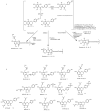Synthesis of Human Phase I and Phase II Metabolites of Hop (Humulus lupulus) Prenylated Flavonoids
- PMID: 35448532
- PMCID: PMC9030851
- DOI: 10.3390/metabo12040345
Synthesis of Human Phase I and Phase II Metabolites of Hop (Humulus lupulus) Prenylated Flavonoids
Abstract
Hop prenylated flavonoids have been investigated for their in vivo activities due to their broad spectrum of positive health effects. Previous studies on the metabolism of xanthohumol using untargeted methods have found that it is first degraded into 8-prenylnaringenin and 6-prenylnaringenin, by spontaneous cyclisation into isoxanthohumol, and subsequently demethylated by gut bacteria. Further combinations of metabolism by hydroxylation, sulfation, and glucuronidation result in an unknown number of isomers. Most investigations involving the analysis of prenylated flavonoids used surrogate or untargeted approaches in metabolite identification, which is prone to errors in absolute identification. Here, we present a synthetic approach to obtaining reference standards for the identification of human xanthohumol metabolites. The synthesised metabolites were subsequently analysed by qTOF LC-MS/MS, and some were matched to a human blood sample obtained after the consumption of 43 mg of micellarised xanthohumol. Additionally, isomers of the reference standards were identified due to their having the same mass fragmentation pattern and different retention times. Overall, the methods unequivocally identified the metabolites of xanthohumol that are present in the blood circulatory system. Lastly, in vitro bioactive testing should be applied using metabolites and not original compounds, as free compounds are scarcely found in human blood.
Keywords: beer; blood analysis; hops; metabolites; prenylated flavonoids; synthesis; xanthohumol.
Conflict of interest statement
The authors declare no conflict of interest.
Figures






Similar articles
-
Stable Isotope Dilution Analysis of the Major Prenylated Flavonoids Found in Beer, Hop Tea, and Hops.Front Nutr. 2020 Dec 15;7:619921. doi: 10.3389/fnut.2020.619921. eCollection 2020. Front Nutr. 2020. PMID: 33385009 Free PMC article.
-
Metabolism of xanthohumol and isoxanthohumol, prenylated flavonoids from hops (Humulus lupulus L.), by human liver microsomes.J Mass Spectrom. 2005 Mar;40(3):289-99. doi: 10.1002/jms.753. J Mass Spectrom. 2005. PMID: 15712367
-
Analytical methods for quantitation of prenylated flavonoids from hops.Curr Anal Chem. 2013 Jan;9(1):71-85. Curr Anal Chem. 2013. PMID: 24077106 Free PMC article.
-
Xanthohumol and related prenylflavonoids from hops and beer: to your good health!Phytochemistry. 2004 May;65(10):1317-30. doi: 10.1016/j.phytochem.2004.04.025. Phytochemistry. 2004. PMID: 15231405 Review.
-
The Multiple Biological Targets of Hops and Bioactive Compounds.Chem Res Toxicol. 2019 Feb 18;32(2):222-233. doi: 10.1021/acs.chemrestox.8b00345. Epub 2019 Jan 22. Chem Res Toxicol. 2019. PMID: 30608650 Free PMC article. Review.
Cited by
-
Physiological Mechanisms by Which the Functional Ingredients in Beer Impact Human Health.Molecules. 2024 Jun 29;29(13):3110. doi: 10.3390/molecules29133110. Molecules. 2024. PMID: 38999065 Free PMC article. Review.
-
Tissue distribution and pharmacokinetics of isoxanthohumol from hops in rodents.Food Sci Nutr. 2023 Dec 29;12(3):2210-2219. doi: 10.1002/fsn3.3900. eCollection 2024 Mar. Food Sci Nutr. 2023. PMID: 38455172 Free PMC article.
-
An Updated Review of the Genus Humulus: A Valuable Source of Bioactive Compounds for Health and Disease Prevention.Plants (Basel). 2022 Dec 8;11(24):3434. doi: 10.3390/plants11243434. Plants (Basel). 2022. PMID: 36559547 Free PMC article. Review.
References
-
- Yang X., Jiang Y., Yang J., He J., Sun J., Chen F., Zhang M., Yang B. Prenylated flavonoids, promising nutraceuticals with impressive biological activities. Trends Food Sci. Technol. 2015;44:93–104. doi: 10.1016/j.tifs.2015.03.007. - DOI
-
- Awouafack M.D., Wong C.P., Tane P., Morita H. Prenylated Flavonoids in Food. In: Xiao J., Sarker S.D., Asakawa Y., editors. Handbook of Dietary Phytochemicals. Springer; Singapore: 2020. pp. 1–23.
-
- Butt M.S., Nazir A., Sultan M.T., Schroën K. Morus alba L. nature’s functional tonic. Trends Food Sci. Technol. 2008;19:505–512. doi: 10.1016/j.tifs.2008.06.002. - DOI
-
- Chang S.K., Jiang Y., Yang B. An update of prenylated phenolics: Food sources, chemistry and health benefits. Trends Food Sci. Technol. 2021;108:197–213. doi: 10.1016/j.tifs.2020.12.022. - DOI
Grants and funding
LinkOut - more resources
Full Text Sources

